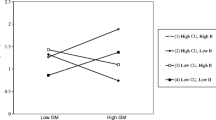Abstract
The present study examined associations between narcissism (total, adaptive, and maladaptive), self-esteem, and externalizing and internalizing problems in 157 non-referred adolescents (aged 14 to 18). Consistent with previous research, narcissism was positively associated with self-reported delinquency, overt aggression, and relational aggression. Maladaptive narcissism showed unique positive associations with aggression and delinquency variables, while adaptive narcissism showed unique negative associations with anxiety symptoms. In general, self-esteem was negatively related to internalizing and externalizing problems. An interaction effect was observed for self-esteem and narcissism in predicting overt aggression. Specifically, at high levels of self-esteem narcissism was significantly associated with overt aggression, whereas it was not at low levels of self-esteem. The current results add to the growing body of research on the role of narcissism in the development of adjustment problems in youth.
Similar content being viewed by others
References
American Psychiatric Association. (1994). Diagnostic and statistical manual of mental disorders (4th ed.). Washington, DC: Author.
Barry, C. T., Frick, P. J., Adler, K. K., & Grafeman, S. J. (2007a). The predictive utility of narcissism among children and adolescents: Evidence for a distinction between adaptive and maladaptive narcissism. Journal of Child and Family Studies, 16, 508–521.
Barry, C. T., Frick, P. J., & Killian, A. L. (2003). The relation of narcissism and self-esteem to conduct problems in children: A preliminary investigation. Journal of Clinical and Child and Adolescent Psychology, 32, 139–152.
Barry, C. T., Grafeman, S. J., Adler, K. K., & Pickard, J. D. (2007b). The relations among narcissism, self-esteem, and delinquency in a sample of at-risk adolescents. Journal of Adolescence, 30, 933–942.
Barry, C. T., Pickard, J. D., & Ansel, L. L. (2009). The associations of adolescent invulnerability and narcissism with problem behaviors. Personality and Individual Differences, 47, 577–582.
Borntrager, C., Davis, J. L., Bernstein, A., & Gorman, H. (2009). A cross-national perspective on bullying. Child & Youth Care Forum, 38, 121–134. doi:10.1007/s10566-009-9071-0.
Calhoun, G. B., Glaser, B. A., Stefurak, T., & Bradshaw, C. P. (2000). Preliminary validation of the narcissistic personality inventory-juvenile offender. International Journal of Offender Therapy and Comparative Criminology, 44, 564–580.
Donnellan, M. B., Trzesniewski, K. H., Robins, R. W., Moffitt, T. E., & Caspi, A. (2005). Low self-esteem is related to aggression, antisocial behavior, and delinquency. Psychological Science, 16, 328–335.
Elliott, D. S., & Ageton, S. S. (1980). Reconciling race and class differences in self-reported and official estimates of delinquency. American Sociological Review, 45, 95–110.
Elliott, D. S., & Huizinga, D. (1984). The relationship between delinquent behavior and ADM problems. Boulder, CO: Behavioral Research Institute.
Emmons, R. A. (1984). Factor analysis and construct validation of the narcissistic personality inventory. Journal of Personality Assessment, 48, 291–300.
Golmaryami, F. N., & Barry, C. T. (2010). The associations of self-reported and peer-reported relational aggression with narcissism and self-esteem among adolescents in a residential setting. Journal of Clinical Child and Adolescent Psychology, 39, 128–133.
Haynie, D. L., Nansel, T., Eitel, P., Crump, A. D., Saylor, K., Yu, K., et al. (2001). Bullies, victims, and bully/victims: Distinct groups of at-risk youth. Journal of Early Adolescence, 21, 29–49.
Holmbeck, G. N. (2002). Post-hoc probing of significant moderational and meditational effects in studies of pediatric populations. Journal of Pediatric Psychology, 27, 87–96.
Jaccard, J., & Turrisi, R. (2003). Interaction effects in multiple regression. Newbury Park: Sage.
Krueger, R. F., Schmutte, P. S., Caspi, A., Moffitt, T. E., Campbell, K., & Silva, P. A. (1994). Personality traits are linked to crime among men and women: Evidence from a birth cohort. Journal of Abnormal Psychology, 103, 328–338.
Lagerspetz, K. M. J., Björkqvist, K., & Peltonen, T. (1988). Is indirect aggression typical of females? Gender differences in aggressiveness in 11-to 12-year-old children. Aggressive Behavior, 14, 403–414.
Marsee, M. A., & Frick, P. J. (2007). Exploring the cognitive and emotional correlates to proactive and reactive aggression in a sample of detained girls. Journal of Abnormal Child Psychology, 35, 969–981.
Obradović, J., Burt, K. B., & Masten, A. S. (2010). Testing a dual cascade model linking competence and symptoms over 20 years from childhood to adulthood. Journal of Clinical Child and Adolescent Psychology, 39, 90–102.
Raskin, R. N., & Hall, C. S. (1979). A narcissistic personality inventory. Psychological Reports, 45, 590.
Raskin, R. N., & Terry, H. (1988). A principal components analysis of the narcissistic personality inventory and further evidence of its construct validity. Journal of Personality and Social Psychology, 54, 890–902.
Rosenberg, M. (1965). Society and the adolescent self-image. Princeton, NJ: Princeton University Press.
Rubin, K. H., Coplan, R. J., & Bowker, J. C. (2009). Social withdrawal in childhood. Annual Review of Psychology, 60, 141–171.
Spence, S. H. (1997). Structure of anxiety symptoms among children: A confirmatory factor analytic study. Journal of Abnormal Psychology, 106, 280–297.
U.S. Department of Education. (2006). National Center for Education Statistics: 2005–06 School Survey on Crime and Safety (SSOCS). Retrieved from http://nces.ed.gov/.
Washburn, J. J., McMahon, S. D., King, C. A., Reinecke, M. A., & Silver, C. (2004). Narcissistic features in young adolescents: Relations to aggression and internalizing symptoms. Journal of Youth and Adolescence, 33, 247–260.
Watson, P. J., & Biderman, M. D. (1993). Narcissistic personality inventory factors, splitting, and self-consciousness. Journal of Personality Assessment, 61, 41–57.
Weems, C. F., Costa, N. M., Watts, S. E., Taylor, L. K., & Cannon, M. F. (2007). Cognitive errors, anxiety sensitivity and anxiety control beliefs: Their unique and specific associations with childhood anxiety symptoms. Behavior Modification, 31, 174–201.
Author information
Authors and Affiliations
Corresponding author
Rights and permissions
About this article
Cite this article
Lau, K.S.L., Marsee, M.A., Kunimatsu, M.M. et al. Examining Associations Between Narcissism, Behavior Problems, and Anxiety in Non-Referred Adolescents. Child Youth Care Forum 40, 163–176 (2011). https://doi.org/10.1007/s10566-010-9135-1
Published:
Issue Date:
DOI: https://doi.org/10.1007/s10566-010-9135-1



